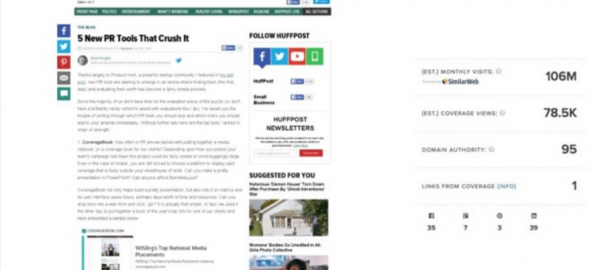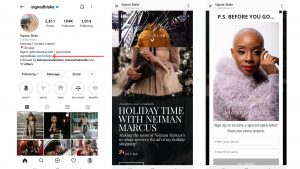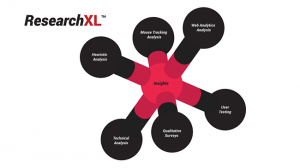Good PR should never be guesswork. Whether it’s for your clients or your own company, your game plan must be on point.
You need data.
And according to Stella Bayles, you probably already have it. You just need to know what it looks like, and how to use it.
As the Director of Coveragebook with than 13 years’ experience in PR, she’s definitely one to know. In a recent webinar with Mention, she showed us how to use data to choose the best influencers for our campaigns, based on data from her own.
Why influencers? Because your PR campaign will be defined by the people you work with. We’re going to look at influencer data to help you choose the right people, and give some real examples.
But first, we need to make a clear distinction.
Think about your original goals
When analyzing a campaign, it’s tempting to look only at the biggest numbers, like pageviews and shares. But while individual metrics are important, what really matters is whether you’ve achieved what you set out to. The influencers that help you do this best are the most important.
Stella makes a distinction between “outcomes” and “outputs.” Others may use the terms KPIs and goals. The outcome of a campaign depends on whether or not you achieved your goals. Outputs (KPIs) are individual metrics along the way that help you reach these goals.
Still unclear? Let’s look at each in more detail.
Outcomes
As noted above, this is the overall result of the campaign, like downloads, sign-ups, and sales. Did you achieve the goals you set for yourself?
You might have several outcomes. You could easily exceed your sales target, but fall short in sign-ups. That’s why it’s important to keep a close eye on which steps helped you succeed or cause you to fall short.
Let’s look at an example. In 2015, Stella wrote Public Relations’ Digital Resolution. Her big goal was obviously to sell books. So she reached out to Paul Sutton, a PR consultant and blogger, for a review.

On the right, you can see that an estimated 783 people saw this review. Stella was confident an endorsement from a trusted PR professional would lead to sales. He also included two links in the piece, so people could buy the book directly.
But this review didn’t lead to any at all:

Instead, a brief mention in a Huffington Post article performed much better. That HuffPo link led to 160 site visits, and 16 actual sales (“goal completions” above).
When you look back at your campaign, the most important data relates to outcomes, not outputs. The influencers who truly help you reach them should be priorities for the future.
As Stella explains, “this is really useful for me to select my influencers for the next campaign. Although I thought the Paul Sutton blog post was going to be more targeted to my audience, we’ll probably work with the blogger on Huffington Post again.”
It connects to Google Analytics and shows you clearly whether you’ve achieved your goals or not. Stick with Google Analytics if you’re comfortable with it, but Answer the Client makes it simpler.
Even if you’re focusing on your goals, you still want to track your outputs closely. They help you gauge how close you are to reaching goals.
Outputs
Once you’ve tracked your outcomes, you still need to measure your outputs. These are individual factors that contribute to the eventual outcome.
Outputs for PR include things like social shares, backlinks, and pageviews. They all help you sell books or get subscriptions, but they aren’t enough on their own.
Don’t obsess over outputs just because they look more impressive. Lots of social shares and pageviews are only relevant when they help you reach your goals. As mentioned above, you should always begin by comparing your campaign against the goals you set for it.
But not every piece of coverage will lead directly to a sale or a download. Sometimes, you’re happy with increased exposure or improved search engine performance.
So what kinds of outputs should you keep an eye on? Here are four real examples, and how to monitor them.
4 key outputs for tracking PR campaigns
Backlinks
Any time someone provides a link to your site from theirs, that’s a backlink. It could be in a blog post, or from someone’s website.
They take people directly from the coverage back to your site or product. As Stella put it, “if anyone clicks on that link, they’ve gone past the point of awareness. They’re taking action.”
Take that Paul Sutton blog post as an example:

Two links give readers two opportunities to click through and buy. These links make it much easier for buyers to buy, and that’s a major plus.
Links also offer a big boost to SEO, making your page rank better on Google. But when earning backlinks, some influencers (or websites) are better than others. Prioritize these based on our next metric.
Domain authority
When reaching out to blogs and websites to share your message, look at their domain authority. As mentioned above, a link back to your page is generally a good thing. But some links are worth more than others.
Domain authority is a score (from 0-100) developed by Moz that tells you how a website will likely rank in search results. A higher score means this site tends to rank well.
When that page links to your content, you get a little boost through SEO. It’s like standing on the shoulders of a giant:

If you can build a small army of authoritative sites linking to your content, your communications will see a major boost.
That boost doesn’t just apply to this campaign, either. Every link to a page on your site increases the domain authority of your site overall. That gives you a big headstart for your next campaign.
Coverage views
You’ve probably heard people talking about “unique views.” This is a popular metric for determining the likely viewership of your content.
Uniques are typically calculated across the whole website. You have no idea whether those people actually saw the specific reference to your campaign.
As an example, here’s that Huffington Post article from earlier:

As you can see, HuffPo had an estimated 106 million visitors the month of this article. But how many of those actually saw this post?
Using Coveragebook‘s own “coverage views” metric, you get an estimated viewership for each specific piece of content. You can compare the benefits of each blog or website more accurately than with simple unique visitors.
When it comes time to plan your next campaign, you’ll have a more accurate estimate of the traffic you can expect from each influencer.
Social shares
If your goals are to increase awareness and (hopefully) drive sales, more shares can’t hurt.
Stella suggests paying special attention to the kinds of coverage that lead to social shares. Speaking about the Huffington Post article, she said they found that this short list was shared far more than other, more focused articles.
“It was shared a lot more when it was a bulleted, snappy, top five list, rather than just a feature about our tool.”
While it’s too late to change the coverage you’ve already received, use this information to plan for the future.“We really dug into how many times each piece of coverage was shared, and who they were shared by. We knew for future campaigns to look for more top five lists, rather than features.”
Make data review a priority
If there’s one major takeaway from Stella’s webinar, it’s to make an effort to analyze your campaigns properly. As she says, “it’s a very busy career, being in communications. We build our reports to share with stakeholders, the rest of our agency, or with our clients. We add the stats quickly, and then the reports are off.
“Often we see the reports as solely being for our clients, but actually, there is so much to learn from them.”
Pay close attention to the tactics that work, and those that don’t. And remember to keep a clear line between outcomes and outputs.
“The best learning you can do is from your own work, and your own teams.”
To learn more about these specific metrics, and how to collect better communications data, watch the full webinar:
Business & Finance Articles on Business 2 Community
(69)





